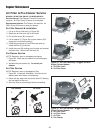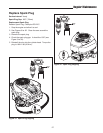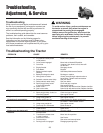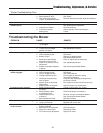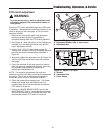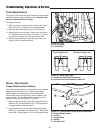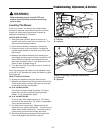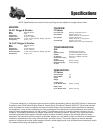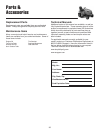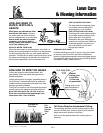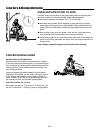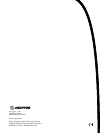
Figure 41. Typical Mower Belt Routing Two Blade
Decks
A. Idler Pulley Arm
B. PTO Pulley (Engine)
C. Mower Upstop
D. Idler Pulley Belt Guide
Left Side of Mower
34
Troubleshooting, Adjustment, & Service
Mower Belt Replacement
Note: It is not necessary to remove the mower to install a
new belt. However, for easier access mower can be
removed. See Mower Removal in the Operation section.
1. Park the tractor on a smooth, level surface such as a
concrete floor. Disengage the PTO, turn off the
engine and lock the parking brake. Remove the key.
2. If mower is not removed, lower the mower lift and
place the mower in the lowest cutting position.
3. Push the idler arm (A, Figure 41 or 42) to relieve belt
tension. Drop the belt from the PTO (electric clutch)
pulley.
IMPORTANT: Note the position of all belt guides relative
to the belt and pulleys before loosening.
4. Some Models. Loosen the belt stop bracket(s) (C).
5. Remove the old belt and replace with a new belt.
Make sure V-side of belt runs in arbor pulley grooves
and the flat backside runs against the idler pulley.
6. Some Models. Position the belt stop bracket(s) (C) in
their original positions. There must be 1/8” clearance
between the belt stop and the pulleys.
7. Position the idler pulley belt guide (D) in its original
position up against arm (A) so that there is a 1/8" gap
between the pulley and belt guide.
8. Install mower on tractor if it was removed. See
Operation section.
9. Run the mower under no-load condition for about 5
minutes
To avoid damaging belts, DO NOT PRY
BELTS OVER PULLEYS.
Figure 42. Typical Mower Belt Routing Three Blade
Decks
A. Idler Pulley Arm
B. PTO Pulley (Engine)
C. Belt Stop Bracket
D. Idler Pulley Belt Guide
Left Side of Mower
C
B
D
A
C
B
D
A
FRONTFRONT
FRONT




